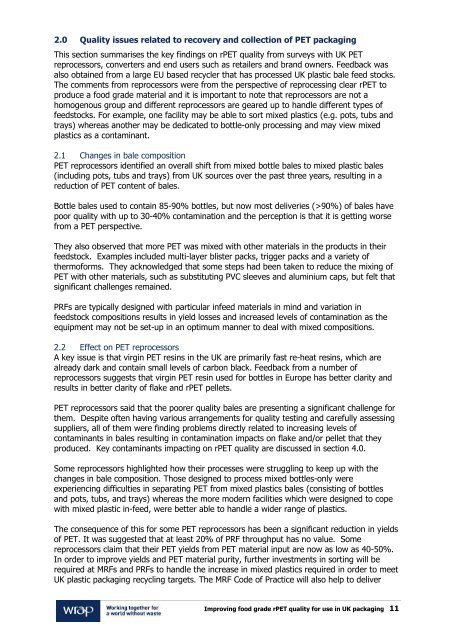rPET Quality Report
You also want an ePaper? Increase the reach of your titles
YUMPU automatically turns print PDFs into web optimized ePapers that Google loves.
2.0 <strong>Quality</strong> issues related to recovery and collection of PET packaging<br />
This section summarises the key findings on <strong>rPET</strong> quality from surveys with UK PET<br />
reprocessors, converters and end users such as retailers and brand owners. Feedback was<br />
also obtained from a large EU based recycler that has processed UK plastic bale feed stocks.<br />
The comments from reprocessors were from the perspective of reprocessing clear <strong>rPET</strong> to<br />
produce a food grade material and it is important to note that reprocessors are not a<br />
homogenous group and different reprocessors are geared up to handle different types of<br />
feedstocks. For example, one facility may be able to sort mixed plastics (e.g. pots, tubs and<br />
trays) whereas another may be dedicated to bottle-only processing and may view mixed<br />
plastics as a contaminant.<br />
2.1 Changes in bale composition<br />
PET reprocessors identified an overall shift from mixed bottle bales to mixed plastic bales<br />
(including pots, tubs and trays) from UK sources over the past three years, resulting in a<br />
reduction of PET content of bales.<br />
Bottle bales used to contain 85-90% bottles, but now most deliveries (>90%) of bales have<br />
poor quality with up to 30-40% contamination and the perception is that it is getting worse<br />
from a PET perspective.<br />
They also observed that more PET was mixed with other materials in the products in their<br />
feedstock. Examples included multi-layer blister packs, trigger packs and a variety of<br />
thermoforms. They acknowledged that some steps had been taken to reduce the mixing of<br />
PET with other materials, such as substituting PVC sleeves and aluminium caps, but felt that<br />
significant challenges remained.<br />
PRFs are typically designed with particular infeed materials in mind and variation in<br />
feedstock compositions results in yield losses and increased levels of contamination as the<br />
equipment may not be set-up in an optimum manner to deal with mixed compositions.<br />
2.2 Effect on PET reprocessors<br />
A key issue is that virgin PET resins in the UK are primarily fast re-heat resins, which are<br />
already dark and contain small levels of carbon black. Feedback from a number of<br />
reprocessors suggests that virgin PET resin used for bottles in Europe has better clarity and<br />
results in better clarity of flake and <strong>rPET</strong> pellets.<br />
PET reprocessors said that the poorer quality bales are presenting a significant challenge for<br />
them. Despite often having various arrangements for quality testing and carefully assessing<br />
suppliers, all of them were finding problems directly related to increasing levels of<br />
contaminants in bales resulting in contamination impacts on flake and/or pellet that they<br />
produced. Key contaminants impacting on <strong>rPET</strong> quality are discussed in section 4.0.<br />
Some reprocessors highlighted how their processes were struggling to keep up with the<br />
changes in bale composition. Those designed to process mixed bottles-only were<br />
experiencing difficulties in separating PET from mixed plastics bales (consisting of bottles<br />
and pots, tubs, and trays) whereas the more modern facilities which were designed to cope<br />
with mixed plastic in-feed, were better able to handle a wider range of plastics.<br />
The consequence of this for some PET reprocessors has been a significant reduction in yields<br />
of PET. It was suggested that at least 20% of PRF throughput has no value. Some<br />
reprocessors claim that their PET yields from PET material input are now as low as 40-50%.<br />
In order to improve yields and PET material purity, further investments in sorting will be<br />
required at MRFs and PRFs to handle the increase in mixed plastics required in order to meet<br />
UK plastic packaging recycling targets. The MRF Code of Practice will also help to deliver<br />
Improving food grade <strong>rPET</strong> quality for use in UK packaging 11



